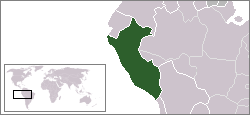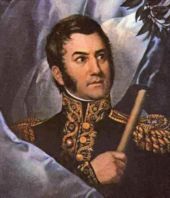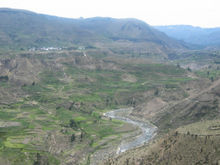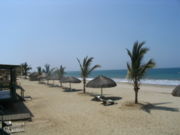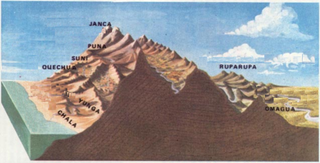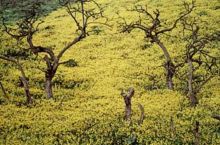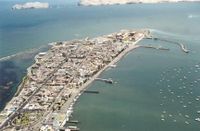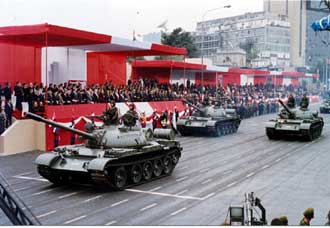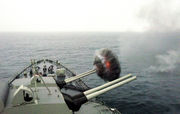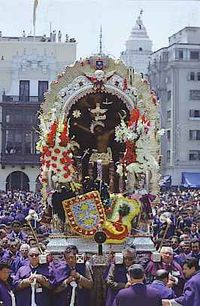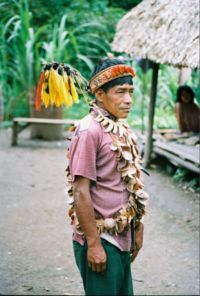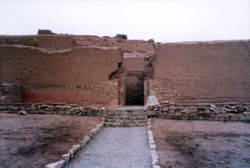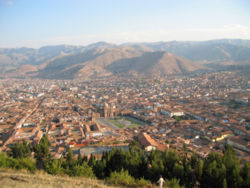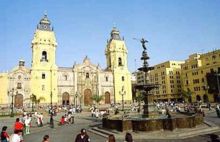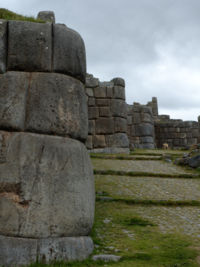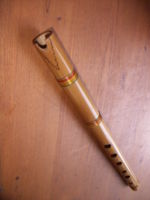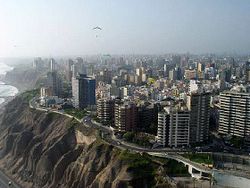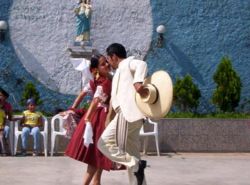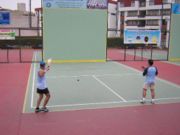Peru
2007 Schools Wikipedia Selection. Related subjects: Central & South American Countries; Countries
| República del Perú Republic of Peru |
|||||
|
|||||
| Anthem: Somos libres, seámoslo siempre "We are free, let us remain so forever" |
|||||
| Capital (and largest city) |
Lima |
||||
| Official languages | Spanish, Quechua, Aymara 1 | ||||
|---|---|---|---|---|---|
| Government | Constitutional republic | ||||
| - President | Alan García Pérez | ||||
| - Prime Minister | Jorge del Castillo | ||||
| Independence | from Spain | ||||
| - Declared | 28 July 1821 | ||||
| Area | |||||
| - Total | 1,285,216 km² ( 20th) 496,222 sq mi |
||||
| - Water (%) | 8.80% | ||||
| Population | |||||
| - July 2005 estimate | 27,968,000 ( 41st) | ||||
| - 2005 census | 27,219,266 | ||||
| - Density | 22/km² ( 183rd) 57/sq mi |
||||
| GDP ( PPP) | 2005 estimate | ||||
| - Total | $167.21 billion ( 50th) | ||||
| - Per capita | $5,983 ( 97th) | ||||
| HDI (2003) | 0.762 (medium) ( 79th) | ||||
| Currency | Nuevo Sol ( PEN) |
||||
| Time zone | ( UTC-5) | ||||
| Internet TLD | .pe | ||||
| Calling code | +51 | ||||
| 1.) Quechua, Aymara and other regional languages are also official in the areas where they are predominant. | |||||
Peru, officially the Republic of Peru (Spanish: Perú or República del Perú pron. IPA [re'pu.βli.ka del pe'ɾu], Quechua: Piruw), is a country in western South America, bordering Ecuador and Colombia to the north, Brazil to the east, Bolivia to the south-east, Chile to the south, and the Pacific Ocean to the west.
In addition to being known as the cradle of the Inca empire, Peru is the home of many indigenous ethnic groups. It is therefore a country with major historical and cultural standing.
History
Ancient cultures
Archaeological evidence present in sites located in the caves of Piquimachay ( Ayacucho), Chivateros, Lauricocha, Paijan, and Toquepala indicates that hunters and gatherers inhabited Peru 20,000 years ago. Some of the oldest notable civilizations appeared ca. 6000 BC in the coastal provinces of Chilca and Paracas and in the highlands province of Callejon de Huaylas.
Over the following 3000 years inhabitants switched to cultivating land, as evidence from sites such as Kotosh and Huaca Prieta shows. Cultivation of plants such as corn and cotton (Gossypium Barbadense) began, as well as the domestication of animals. Inhabitants practiced domestic crafts such as spinning and knitting of cotton and wool, basketry and pottery.
Some of the more advanced Andean civilizations that appeared in 900 BC were:
- Caral
- Chavin – the Peruvian Mother Culture, according to Julio C. Tello
- Paracas
- Mochica
- Nazca
- Tiahuanaco
- Wari
- Chimu
These cultures developed relatively advanced techniques of cultivation, gold and silver craft, pottery, metallurgy, and knitting. Around 700 BCE, they appear to have developed systems of social organization that were the precursors of the Inca civilization.
Minor civilizations on the edge of the eastern Andes that were largely assimilated into the Incan empire include:
- Malbecs
- Hu-Tyus
- Punos
- Mari-Tiu-Tie
- Olbraqeus
Not all Andean cultures were willing to offer their loyalty to the Incas as they expanded their empire, and many were openly hostile. The people of the Chachapoyas culture were an example of this, but they were eventually conquered and integrated into the Inca Empire.
The Incas
The Incas created the most vast and powerful empire of pre-Columbian America. The Tahuantinsuyo—which is derived from Quechua for "The Four United Regions"—reached its greatest extension at the beginning of the 16th century. It dominated a territory that included from north to south Ecuador, part of Colombia, the northern half of Chile, and the north-east part of Argentina; and from west to east, from Bolivia to the Amazonian forests.
The empire originated from a tribe based in Cuzco, which became the capital. Pachacuti was the first ruler to considerably expand the boundaries of the Cuzco state. His offspring later ruled an empire by both violent and peaceful conquest.
In Cuzco, the royal city was created to resemble a puma; the head, the main royal structure, formed what is now known as Sacsayhuaman. The Empire's administrative, political, and military centre was located in Cuzco. The empire was divided into four quarters: Chinchasuyo, Antisuyo, Contisuyo, and Collasuyo.
Quechua was the official language, imposed on the citizens. It was the language of a tribe neighbouring the original tribe of the empire. Conquered populations—tribes, kingdoms, states, and cities—were allowed to practice their own religions and lifestyles, but had to recognize Inca cultural practices as superior to their own. Inti, the sun god, was to be worshipped as one of the most important gods of the empire. His representation on earth was the "Inca", the Emperor .
The Tahuantinsuyo was organized in dominions with a stratified society, in which the ruler was the Inca. It was also supported by an economy based on the collective property of the land. In fact, the Inca Empire was conceived like an ambitious and audacious civilizing project, based on a mythical thought, in which the harmony of the relationships between the human being, nature, and gods was truly essential.
Many strange and interesting customs were observed, for example the extravagant feast of Inti Raymi which gave thanks to the God Sun, and the young women who comprised the Virgins of the Sun, sacrificial virgins devoted to the Inti. The empire, being quite large, also had an impressive transportation system of roads to all points of the empire called the Inca Trail, and chasquis, message carriers who relayed information from anywhere in the empire to Cuzco.
From the European rationalist perspective, the Inca Empire has been seen like the utopia state. Nevertheless, this pragmatic interpretation tends to forget that the collision between two antithetic Weltanschauungs had a destructive impact on the harmony of the Inca Weltanschauung superiority, who took advantage of the Inca civil war triggered by two pretenders to the throne.
Colonial Peru (Spanish rule)
Francisco Pizarro and his brothers were attracted by the news of a rich and fabulous kingdom. In 1531, they arrived in the country, which they called Peru. (The forms Biru, Pirú, and Berú are also seen in early records.) According to Raul Porras Barrenechea, Peru is not a Quechuan nor Caribbean word, but Indo-Hispanic or hybrid.
At that moment, the Inca Empire was sunk in a five years civil war between two princes, Huáscar and Atahualpa. Taking advantage of this, Pizarro carried out a coup d’état. On November 16, 1532, while the natives were in a celebration in Cajamarca, the Spanish in a surprise move captured the Inca Atahualpa during the Battle of Cajamarca, causing a great consternation among the natives and conditioning the future course of the fight. When Huascar was killed, the Spanish tried and convicted Atahualpa of the murder, executing him by strangulation.
For a period, Pizarro maintained the ostensible authority of the Inca, recognizing Tupac Huallpa as the Inca after Atahualpa's death. But the conqueror’s abuses made this façade too obvious. Spanish domination consolidated itself as successive indigenous rebellions were bloodily repressed. The situation was complicated by a power struggle between the Pizarro family and Diego de Almagro. A long civil war developed, from which the Pizarros emerged victorious at the Battle of Las Salinas.
Despite this, the Spaniards did not neglect the colonizing process. Its most significant milestone was the foundation of Lima in January, 1535, from which the political and administrative institutions were organized. The necessity of consolidating Spanish royal authority over these territories, led to the creation of a Real Audiencia (Royal Audience). In 1542, the Spanish created the Viceroyalty of New Castilla, that shortly after would be called Viceroyalty of Peru. Nevertheless, the Viceroyalty of Peru was not organized until the arrival of the Viceroy Francisco de Toledo in 1572.
Toledo ended the indigenous state of Vilcabamba, executing the Inca Tupac Amaru. He also sought economic development through commercial monopoly and mineral extraction, mainly from argentiferous mines of Potosí. He exploited the Inca institution called “ mita”, that is mandatory public service, to put the native communities under a cruel economic enslavement.
The Viceroyalty of Peru became the richest and most powerful Spanish Viceroyalty of America in the 18th century. The creation of the Viceroyalties of New Granada and Rio de la Plata (at the expense of its territory), the duty exemptions that moved the commercial centre from Lima to Caracas and Buenos Aires, and the decrease of the mining and textile production determined the progressive decay of the Viceroyalty of Peru. These events created a favorable climate so that emancipating ideas developed between the Spanish Criollo people, or Creoles.
Wars of independence
The economic crisis favored the indigenous rebellion from 1780 to 1781. This rebellion was headed by Túpac Amaru II. At this time, the Napoleonic invasion of the Iberian Peninsula and the degradation of the Royal power took place. The Creole rebellion of Huánuco arose in 1812 and the rebellion of Cuzco arose between 1814 and 1816. These rebellions defended the liberal principles sanctioned by the Constitution of Cadiz of 1812.
Supported by the power of the Creole oligarchy, the Viceroyalty of Peru became the last redoubt of the Spanish dominion in South America. This Viceroyalty succumbed after the decisive continental campaigns of Simón Bolivar and Jose de San Martin. San Martin, who had displaced the royalists of Chile after the magnificent battle of the Andes, and who had disembarked in Paracas in 1819, proclaimed the independence of Peru in Lima on July 28, 1821. Three years later, the Spanish dominion was eliminated definitively after the battles of Junín and Ayacucho. Its first elected president, however, wasn't in power until 1827.
War and reconstruction
In 1879, Peru entered the War of the Pacific which lasted until 1884. Bolivia invoked its alliance with Peru against Chile. The Peruvian Government tried to mediate the dispute by sending a diplomatic team to negotiate with the Chilean government, but the committee concluded that war was inevitable. Chile declared war on April 5, 1879. Almost five years of war ended with the loss of the department of Tarapacá and the provinces of Tacna and Arica, in the Atacama region.
After the war, an extraordinary effort of reconstruction began. Political stability was achieved only in the early 1900s. The civilist movement headed by Nicolas de Piérola opposed the military caudillismo that arose from the warlike defeat and the economic collapse. He arrived to power with the 1895 revolution. The reformist character of Pierola’s dictatorship had continuity in Augusto B. Leguía’s.
During Leguia’s government periods ( 1908– 1912 and 1919– 1930, this last one was well-known as “the Oncenio”—The eleventh), the entrance of American capitals became general and the bourgeoisie was favored. This politics along with the increase of the foreign capital dependency, contributed to generate opposition focuses between the landowner oligarchy as much as the most progressive sectors of the Peruvian society.
In 1929, Peru and Chile signed a final peace treaty, the Treaty of Ancon by which Tacna returned to Peru and Peru yielded permanently the rich provinces of Arica and Tarapaca, but kept certain rights to the port activities in Arica and decisions of what Chile can do on those territories.
After the world-wide crisis of 1929, numerous brief governments followed one another. The APRA party had the opportunity to cause system reforms by means of political actions, but it was not successful. Represion was brutal in the early 1930's and tens of thousands of "APRISTA" followers were executed or imprisoned. By this time, it begins a sudden population growth and an urbanization increase. During World War II, Peru was the first South American nation to align with the United States and its allies against Germany and Japan.
Between these two periods of time, it should be underlined the constitution of the American Popular Revolutionary Alliance (APRA). This is a nationalistic movement, populist and anti-imperialist headed by Victor Raul Haya de la Torre in 1924. The communist party was created four years later and it was led by Jose C. Mariategui.
Modern politics
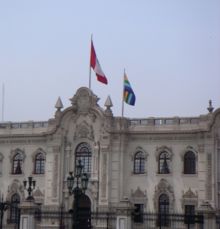
General Manuel A. Odría led a dictatorial military government that lasted for eight years ( 1948– 1956). Inequitable land tenure (latifundia), wide-spread social marginalization and the Cuban example provided the impetus in the early 1960s for the emergence of Peru's armed left. But this resurgence was brief and gave the pretext for the armed forces to increase their control of the country and gather the strength and alternative ideology necessary for a coup d'etat
Meanwhile, the reformist attempt of Fernando Belaunde Terry’s first government failed to address the structural nature of social pathology, which continued to plague Peru. Belaunde's Government embraced numerous projects, including the Carretera Marginal de la Selva, a highway linking Chiclayo on the Pacific coast with previously "isolated" northern regions of Amazonas, San Martín, and Loreto. However, Belaunde was saddled with the popular perception that he was too close to foreign capital, moreover his economic decisions lead to the devaluation of the sol, and generalized unrest—both in the countryside and in Lima.
In 1968, General Juan Velasco Alvarado’s lead a coup d'etat replacing the Belaunde government. Under the title of "President of the Revolutionary Government", the nationalist and left-leaning tone of Velasco was manifest by his government's promulgation of Peru's first substantial agrarian reform, which was aimed at stemming the tide of civil unrest, particularly in the Andes where land ownership patterns were profoundly inequitable. Velasco's government is credited with promoting peasant's rights, including the recognition of Quechua as a national language, communal land ownership, and populist social mobilization (SINAMOS).
Invariably, this gave rise to conflict with Peru's small elite, those with foreign capital interests and local oligarchs. Velasco's failing health, changed global conditions and poor planning resulted in a counter-reaction to Velasco's nationalist program. In 1975, General Francisco Morales Bermúdez’s lead a coup d’etat, replacing Velasco as President. Morales Bermúdez's regime was characterized by a return to elite-oriented politics, which did little to stem civil unrest from a populace largely excluded from the social benefits of national citizenship.
Frustrated by their inability to "rule" Peru, the Peruvian Armed Forces were forced to call for elections. Meanwhile, as a background to the return to elected government two events that would deeply influence the next two decades of peruvian history took place. The first was a constitutional convention that resulted in a new national constitution in 1979. The second was the start in 1980 of the armed struggle against the government by Shining Path, a breakaway faction of the Communist Party of Peru. It was not by coincidence that this struggle started in one of the poorest regions of the country while the new constitution was hammered out in the capital and away from the focus of disenfranchisement.
So, with great hope Fernando Belaúnde Terry was re-elected in 1980 to the Presidency. However, by the end of his term in 1985, Peru yet again faced a crisis that has gripped Peru for the past two decades: mounting external debt has stymied the actions of successive Peruvian governments. Moreover, Belaúnde was impotent in halting the progressive impoverishment of the vast majority of population, and incapable of halting the massive increase in drug trafficking operations, or the insurgent revolts of the Shining Path (Sendero Luminoso) and the Tupac Amaru Revolutionary Movement (MRTA).
With much optimism, the leader of Peru's APRA Party, Alan Garcia was elected President in 1985. After a promising start, the Peruvian economy was crippled by hyperinflation, isolated from the international financial community, and was in the throes of a bloody civil-war pitting the Shining Path and the Tupac Amaru Revolutionary Movement against the State and its allies. In a climate of generalized chaos, terror, and political violence, the electoral victory of Alberto Fujimori took place in 1990, when the virtually unknown University Rector narrowly defeated the famous Peruvian novelist and cultural icon Mario Vargas Llosa. Like his predecessor, García relinquished power leaving the country, according to many Peruvians, in a worse state than when he entered office.
Two years after he was elected; and in constant deadlocks with the Parliament, President Alberto Fujimori summarily closed Congress and convened a referendum for elaborating a new Constitution (1992). Credited by some sectors of Peruvian society and the international financial community with restoring macroeconomic "stability" to Peru after the turbulent Garcia years, Fujimori was widely criticized for what his opponents describe as an authoritarian regime, aided by the now imprisoned Vladimiro Montesinos, the former head of Peru's intelligence service, Servicio de Inteligencia Nacional (SIN).
Following a controversial third "re-election", mounting corruption, wide-spread political violence and gross human rights violations, Fujimori was forced to call for early elections. After his party lost control of the Peruvian Parliament, he was forced to resign from the Presidency of Peru. Returning from the APEC summit in Brunei, Fujimori requested political asylum in Japan on the grounds of his Japanese citizenship.
In the turmoil following Fujimori's precipitous fall from power, Valentín Paniagua was selected as the transitional President. Following a hotly contested election, Alejandro Toledo became President (2001-2006), narrowly defeating Alan García (2006).
In 2006, Alan García was once again elected President, defeating nationalist candidate Ollanta Humala. After his political defeat, Ollanta Humala has faced several trials for his involvement in the fight against Sendero Luminoso and his role as opposition leader has faded away. Former President Alberto Fujimori (currently in Chile) is awaiting extradition proceedings against him by the Peruvian government , while at the same time his political party Alliance for the Future gathered an important number of parliament members in the last elections. Former Presidents Alejandro Toledo and Valentín Paniagua are represented in congress with the Peru Possible- Centre Front Alliance.
Politics of Peru
The formal politics of Peru takes place in a framework of a presidential representative democratic republic, whereby the President of Peru is both head of state and head of government, and of a pluriform multi-party system. Executive power is exercised by the government. Legislative power is vested in both the government and the Congress. The Judiciary is supposed to be independent of the executive and the legislature.
Cities
The primary urban centers include:
- Lima (the capital, the primary economic and cultural centre)
- Arequipa
- Trujillo
- Chiclayo
- Callao (Peru´s largest port)
- Cusco (the modern capital of the ancient Inca Empire)
- Piura
- Tacna
- Ica
- Puno
- Chimbote
- Huancayo
- Huacho
- Cajamarca
- Pucallpa
- Iquitos
- Yurimaguas
- Tarapoto
- Moyobamba
Geography
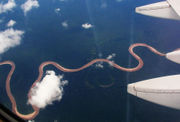
At 1,285,220 km² (496,193 mi²) , Peru is the world's 20th-largest country (after Mongolia). It is comparable in size to Chad, and is nearly twice the size of the US state of Texas.
Peru's territory has an area of 1,285,216 km². It is bordered by Ecuador and Colombia on the north, Brazil and Bolivia to the east, and finally Chile and Bolivia to the south. To the west lies the Pacific Ocean. Its population has more than 27 million inhabitants that speak Spanish, with others bilingual in Quechua or Aymara and other native languages.
Eastern Peru consists mostly of the moist tropical jungles of the Amazon Rainforest, the largest on Earth. In the southeast along the border with Bolivia lies Lake Titicaca — the highest navigable lake in the world. The Altiplano plateau is a dry basin located along the slopes of the Andes in southeastern Peru. Along the border with Chile, the Atacama Desert is the driest place on the planet.
The Peruvian Sea is home to a large amount and variety of fish life. The Sechura Desert is located in northwestern Peru along the Pacific coastline.
The main rivers of Peru include the Ucayali, Marañón, Amazon (which is formed by the confluence of the Marañón and the Ucayali), Putumayo, Pastaza, Napo, Jurua, and the Purus.
Physiographic regions
When the Spanish arrived, they divided Peru (because of political reasons) into three main regions: the Coastal region, which is bounded by the Pacific Ocean; the Highlands, that is located in the Andean Heights, and the Jungle, which is located on the Amazonian Jungle. These words are still used in Peru. However, Javier Pulgar Vidal, a geographer who studied the biogeographic reality of the Peruvian territory for a long time, proposed the creation of eight Natural Regions. In 1941, the III General Assembly of the Pan-American Institute of Geography and History approved this motion.
These eight Peruvian regions are:
- Chala or Coast (a subtropical desert in the central and southern coast and a changing tropical savanna in the north coast)
- Yunga (consisting of subtropical arid fertile valleyes)
- Quechua
- Suni or Jalca
- Puna
- Janca
- Rupa - Rupa or High Jungle
- Omagua or Low Jungle
Natural and cultural Peruvian heritage
The Peruvian constitution of 1993 recognised the natural resources and ecosystem variety of its country as a heritage. In 1900, the National System of Natural Areas that are protected by the Peruvian Government (SINANPE) was created. This entity depends on the National Institute of Natural Resources (INRENA). They also created a map of protection and preservation of historical – cultural heritage and nature.
This map has 49 natural areas (13% of the country surface) that are preserved by the Government: 8 national parks, 8 national reservations, 6 national sanctuaries, 3 historical sanctuaries, 4 national forests, 6 protection forests, 1 communal reservation, 2 hunting enclosed lands and 11 reserved zones.
National Parks are places where the wild flora and fauna are protected and preserved. Natural resources exploitation and human settlements are forbidden.
National parks
- Cutervo It is the oldest Peruvian National Park. It was created in 1961 and is located in Cajamarca. There are many caves in this park such as San Andres Cave, where the guacharo lives - a bird in danger of extinction.
- Tingo Maria It is located in Huanuco. Its principal attraction is the Cueva de las Lechuzas ( Owl Cave) where the guacharos live.
- Manu It is located in Madre de Dios and Cuzco. Its the most representative area of the Amazon biodiversity. In 1977, UNESCO recognised it as a Reserve of Biosphere and in 1987, it was pronounced as Natural Heritage of Humanity.
- Huascaran It is located in Ancash. It was also pronounced as Natural Heritage of Humanity and recognised as Reserve of Biosphere Core. The highest snow-covered mountain is here (which name is also Huascaran and has 6 768 m.). This park is the habitat of the Puya Raimondi, the American panther or puma, the jaguar, the llama, the guanaco, the Marsh Deer, the Peruvian tapir, the Peruvian Piedtail, a hummingbird species, and many kinds of ducks.
- Cerros de Amotape (Amotape Hills) It is located in Piura and Tumbes. It has a lot of dry-climate forests and some endangered species like the American Crocodile.
- Abiseo River It is located in San Martín. UNESCO pronounced it as Natural and Cultural Heritage of Humanity.
- Yanachaga-Chemillen It is located in Pasco. It is a preservation zone of tropical forests that are at 4 800 m. The Palcazu river, Huancabamba river, Pozuzo river and their affluents flows through this National Park. Some native communities still live in here. There are also some archaeological fields from the Inca and Yanesha cultures.
- Bahuaja-Sonene It is located in Madre de Dios. It has the tropical forests of Puno, the Heath Pampas and a part from the Reservation Zone Tambopata-Candamo.
National reservations, protection and spreading areas of wild fauna
- Pampa Galeras – Barbara D’Achille It is located in Ayacucho and it is the habitat of the vicuña.
- Junin It is located in Junin. One of its main purposes is to protect the ecosystem and biodiversity of Lake Junin.
- Paracas It is located in Ica. Its main purpose is to preserve the sea ecosystem and protect the historical - cultural heritage.
- Lachay It is located in Lima. Its main purpose is to restore and protect the ecosystem of the Lomas de Lachay (Lachay hills).
- Pacaya-Samiria It is located in Loreto. Its main purpose is to preserve the ecosystems of the Omagua Region and to promote the indigenous towns.
- Salinas and Aguada Blanca They are located in Arequipa and Moquegua. Their main purpose is to preserve the flora, fauna and the landscapes formation.
- Calipuy It is located in La Libertad. Its main purpose is to protect the guanaco’s populations.
- Titicaca It is located in Puno. Its main purpose is to preserve the ecosystems and landscapes of the Titicaca lake.
National sanctuaries
- Huayllay
- Calipuy
- Lagunas de Mejia (The Mejia lagoon)
- Ampay
- Manglares de Tumbes (The mangrove swamps of Tumbes)
- Manglares de Vice, found in the Sechura Province of Piura Region (smaller than the Manglares de Tumbes National Sanctuary, are the southernmost mangrove swamp system in the Pacific region)
- Tabacones Namballe
Historical sanctuaries
- Chacramarca
- Pampas de Ayacucho (The Pampas of Ayacucho)
- Machu Picchu
National forests
- Biabo Cordillera Azul (The Biabo Blue Mountain Range)
- Mariscal Cáceres
- Pastaza–Morona–Marañon
- Alexander von Humboldt
Protection forests
- Aledaño Bocatoma del Canal Nuevo Imperial (Aledaño Intake of the New Imperial Canal)
- Puquio Santa Rosa (Santa Rosa spring of water)
- Pui–Pui
- San Matías–San Carlos
- Alto Mayo
- Pagaibamba
Communal reservation
- Yanesha
Hunting enclosed lands
- Sunchubamba
- El Angolo
Reserved zones
- Manu
- Laquipampa
- Apurimac
- Pantanos de Villa (The swamps of Villa)
- Tambopata–Candamo
- Batán Grande
- Algarrobal El Moro (El Moro carob tree groved)
- Tumbes
- Güeppí
- Chancaybaños
- Aymuru Lupaca
Economy
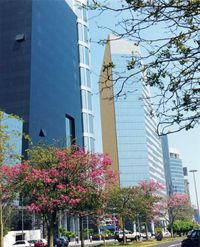
Since 1990, the Peruvian economy has undergone considerable free market reforms, from legalizing parts of the informal sector to significant privatizations in the mining, electric/power, and telecommunications industries. Aided by foreign investment and cooperation between the former Fujimori administration, the IMF, and the World Bank, economic growth was rapid in 1994– 97 and inflation was kept low.
Still, some say that Peru's reforms have not led to sustained economic progress. According to the Centre for Economic and Policy Research, a U.S.-based think tank, "Income per person in Peru – the most basic economic measure of living standards – is currently about the same as it was 25 years ago. This is a remarkable long-term economic failure."
In 1998, El Niño's impact on agriculture, the financial crisis in Asia, and instability in Brazilian markets undercut growth. 1999 was another lean year for Peru, with the aftermath of El Niño and the Asian financial crisis having an avdersely effect on the market economy. Lima did manage to complete negotiations for an Extended Fund Facility with the IMF in June 1999, although it subsequently had to renegotiate the targets. Pressure on spending grew in the run-up to the 2000 elections.
Growth up to the year 2005 has been realized by construction, investment, domestic demand and exports. Peru's economy has become one of the most liberal market economies in Latin America. The country's petroleum, natural gas and power industries are expected to increase due to relatively high domestic and foreign influx of capital in the tourism, agriculture, mining and construction sectors since 1995.
In April 2006, Peru signed a trade agreement with the United States (known as the Peru Trade Promotion Agreement, becoming the first country in the Andean Community of Nations ( Comunidad Andina de Naciones, CAN) to sign it. As of June 2006, Peru's Congress has already approved the agreement and the pact awaits approval by the U.S. Congress. Peru is currently negotiating trade agreements with Chile, Mexico, Singapore and India.
Peru has free trade agreements with the Andean Community, which is composed of Colombia, Ecuador, Bolivia and Venezuela. It also has free trade agreements with many of the countries in Mercosur as well as Thailand, and during the recent APEC summit, Peru declared intentions to sign free trade agreements with China, Japan, and South Korea.
Peru is also seeking a free trade agreement with the European Union. These negotiations will greatly expand the markets in which the Peruvian products are traded. Peru has potential to export agricultural products, textiles, clothing, shoes, petroleum derivatives, natural gas, minerals, as well as fish and seafood products, tourism, and manufactured goods.
In 2005 Peruvian exports were worth US$ 17.1 billion (an increase of 34.6% compared to 2004) and it is expected to grow 35% for this year reaching US$ 23.5 billion at the end of 2006. The markets of Peru have grown in all sectors (energy, construction, commerce, fishing, manufacturing, tourism, etc) in 2005 growing over 6.67% (one the fastest growth rates of market economies in South America) and it is projected to grow 7% for 2006.
For the next five years (until 2010) the Peruvian government has registered more than US$ 10 billion in private investment (both domestic and foreign) in the mining and energy sectors, as well as investments of US$ 15 billion in other sectors such as industry, commerce, tourism, seafood and agriculture, which will keep the economy growing annually at levels of 5% or more.
Poverty in Peru is high, with a poverty threshold level of 48% of the total population. However, the level is reducing slowly and it is expected to diminish to 20% of the population within 10 years.
Military
The Military branches of the Republic of Peru are as follows:
- Ejército del Perú ( Peruvian Army)
- Marina de Guerra del Perú ( Peruvian Navy, includes Naval Air, Naval Infantry and Coast Guard)
- Fuerza Aérea del Perú ( Peruvian Air Force)
In the last few years social stability has brought the army back to its original objectives - control of the national sovereignty on the sea, land and air, as well as to protect the people, economy, and infrastructure from threats from both inside and outside of the country.
Peruvian Army
Headquartered in Lima, it has a strength of 75 thousand troops divided in four military regions with headquarters in Piura, Lima, Arequipa and Iquitos. Every military region assigned several brigades of which there are different types, including infantry, cavalry and armored. There are also several groups and battalions which operate independently.
The equipment of the Peruvian Army includes several types of tanks ( T-55 and AMX-13), armoured personnel carriers ( M-113, UR-416), artillery ( D30 howitzer, M101 howitzer, M109 howitzer, M114 howitzer), antiaircraft systems ( ZSU-23-4 Shilka) and helicopters ( Mil Mi-2, Mil Mi-17).
Peruvian Navy
Peruvian Navy (Marina de Guerra del Perú) is organized in five naval zones headquartered in Piura, Lima, Arequipa, Iquitos and Pucallpa. It has a strength of around 25 000 troops divided between the Pacific Operations and the Amazon Operations General Commands and the Coast Guard.
The Pacific fleet flagship is the cruiser BAP Almirante Grau (CLM-81), named for the XIX-century Peruvian Admiral which fought in the War of the Pacific (1879-1883). The fleet also includes 8 Lupo class frigates (two of which were built in Peru during the 80's), 1 Daring class destroyer, 6 PR-72 class corvettes, 4 Terrebonne Parish class landing ships, 6 Type 209/1200 class German-built diesel submarines (the biggest submarine force in South America), as well as patrol vessels, tankers and cargo ships.
Peruvian Navy has also a naval aviation force, several naval infantry battalions and special forces units.
Peruvian Air Force
On May 20, 1929, the aviation divisions of the Peruvian army and navy were merged into the Peruvian Aviation Corps (CAP, Cuerpo de Aviación del Peru). In 1950, the corps was reorganized again and became the Peruvian Air Force (FAP, Fuerza Aerea del Peru).
The Peruvian Air Force (Fuerza Aerea del Peru - FAP) is divided into 6 wing areas, headquartered in Piura, Chiclayo, Lima, Arequipa, Rioja and Iquitos. With a strength of 35 thousand troops, the FAP counts in its arsenal MiG-29, MiG-25, Mirage 2000, Mirage M5 and SU-22 supersonic aircraft.
Also, it has SU-25 antitank aircraft, as well as MI-24 antitank helicopters, MI-8, MI-17 transport helicopters, and Aermacchi, A-37 Cessna and SuperTucano Embraer subsonic aircraft.
In 1995, the FAP took part in the Cenepa War against Ecuador covering operations by the army and navy. After the war, the FAP began acquiring new material, especially MiG-29 fighters and Su-25 attack fighters which are, along with the Mirage 2000 fighters, the main combat elements of the FAP.
Demographics
Ethnography
Peru is one of only three Latin American countries which have their largest population segment consisting of indigenous Amerindians, with around 45% of all Peruvians classified as such. Most are found in the southern Andes, though a large portion are also to be found in the southern and central coast due to the massive internal labor migration from remote Andean regions to coastal cities, especially Lima, during the past four decades. While the Andes are the "heart" of indigenous Peru, the country's Amazonian region represents nearly 60% of Peruvian national territory and harbors a wide variety of indigenous groups that is rivaled only by its biodiversity. These tropical lowlands, however, are sparsely populated.
The two major indigenous or ethnic groups are the Quechuas (belonging to various cultural subgroups), followed by the Aymaras, mostly found in the extreme southern Andes. A large proportion of the indigenous population who live in the Andean highlands still speak Quechua or Aymara, and have vibrant cultural traditions, some which were part of the Inca Empire, arguably the most advanced agricultural civilization in the world. Literally dozens of indigenous cultures are also dispersed throughout the country beyond the Andes Mountains and in the Amazon basin.
Peru's Amazonian region is rapidly becoming urbanized. Important urban centers include Iquitos, Nauta, Puerto Maldonado, Pucallpa and Yurimaguas. This region is home to numerous indigenous peoples, though they do not constitute a large proportion of the total population. Examples of indigenous peoples residing in eastern Peru include the Shipibo, Urarina, Cocama, and Aguaruna, to name just a few.
At the national level, mestizos constitute the second largest segment of the population, at around 37% of the total population. The term traditionally denotes people of mixed European and Amerindian ancestry, and most Peruvian mestizos are of this combination, but other lineages (most notably African) are also present, in varying degrees, in some segements of the mestizo population. Most mestizos are urban dwellers and can be seen in coastal cities of the north coast, where they show stronger Spanish inheritance, the central coast like Lima Region, Cajamarca Region, and also Arequipa Region.
Around 15% of the population is classified as " White", and they are for the most part criollos, the relatively unmixed descendants of the colonial Spanish colonizers. Descendants of Italian and other small group of German, Yugoslavs and other Europeans represent a relatively smaller proportion of the overall White population. The majority of the White criollos live in the largest cities, concentrated usually the northern coastal citites of Trujillo, Chiclayo, Piura, and of course the capital Lima. The only southern city with a significant White population is Arequipa. To the north Cajamarca and San Martin are also cities with a strong spanish influence.
The remaining 3% of the population is of black African ancestry. The Afro-Peruvians, a legacy of Peru's history as an importer of slaves during the colonial period. Today also mulattos (mixed African and European) and zambos (mixed African and Amerindian) constitude an important part of the population as well, especially in Piura, Tumbes, Lambayeque, Lima and Ica regions.
The Afro-Peruvian population is concentrated mostly in coastal cities south of Lima, such as that of those found in the Ica Region, in cities like Cañete, Chincha, Ica, Nazca and Acari in the border with the Arequipa Region. Other large but poorley promoted segement of Afro-Peruvian presence is in the Yunga regions (west and just below the Andean chain of northern Peru) where sugarcane, lemon and mango production is still of importance, that is Piura and Lambayeque. Important communities are found all over the Morropon Province, such as in the city of Chulucanas, Yapatera town of the same city, and other even smaller farming towns like Pabur or La Matanza and even in the mountainous region near Canchaque. Further south, the colonial city of Zaña or farming towns like Capote and Tuman in Lambayeque are also important regions with Afro-Peruvian presence.
There is also a large presence of Asians, primarily Japanese and Chinese, that constitute some 3% of the population, which in proportion to the overall population is the largest of any Latin American nation.
Peru has the second largest population of people of Japanese descent in Latin America after Brazil and the largest population of Cantonese descent in Latin America. Historic communities inhabited by people of Chinese descent are found throughout the Peruvian upper Amazon, including cities such as Yurimaguas, Nauta, Iquitos and the north central coast (Lambayeque and Trujillo). In contrast to the Japanese community in Peru, the Chinese appear to have intermarried much more since they came to work in the rice fields during the Viceroyalty and to replace the African slaves, during the abolition of slavery itself.
Language
Peru's official languages are Spanish and, according to the Peruvian Constitution of 1993, Amerindian languages such as Quechua, Aymara and other such indigenous languages in areas where they predominate. Today, Spanish is spoken by some 80.3% of the population, and is the language used by government, media, and in education and formal commerce. There has been an increasing and organized effort to teach Quechua in public schools in the areas where Quechua is spoken.
According to official sources, the use of Spanish has increased while the knowledge and use of indigenous languages has decreased considerably during the last four decades ( 1960- 2000). At the beginning of the 1960s some 39% of the total Peruvian population were registered as speakers of indigenous languages, but by the 1990s the figures show a considerable decline in the use of Quechua, Aymara and other indigenous languages, when only 28% is registered as Quechua-speaking (16% of whom are reported to be bilingual in Spanish) and Spanish-speakers increased to 72%.
For 2005, government figures place Spanish as being spoken by 80.3% of the population, but among Amerindian languages another decrease is registered. Of the indigenous languages, Quechua remains the most spoken, and even today is used by some 16.2% of the total Peruvian population, or a third of Peru's total indigenous population. The number of Aymara-speakers and other indigenous languages is placed at 3%, and foreign languages 0.2%.
The drastic decline in use and knowledge of indigenous languages is largely attributed to the recent demographic factors. The urbanization and assimilation of Peru's Amerindian plurality into the Hispanic-mestizo culture, as well as the new socioeconomic factors associated with class structure have given privilege to the use of Spanish at the expense of the Amerindian languages which were spoken by the majority of the population less than a century ago.
The major obstacle to a more widespread use of the Quechua language is the fact that multiple dialects of this language exist. The variations among these Quechua dialects are as pronounced as - for example - the differences between Spanish, Portuguese and Italian. Quechua, along with Aymara and the minor indigenous languages, was originally and remains essentially an oral language. Therefore, there is a lack of modern media which use it: for example books, newspapers, software, magazines, technical journals, etc. However, non-governmental organizations as well as state sponsored groups are involved in projects to edit and translate major works into the Quechua language; for instance, in late 2005 a superb version of Don Quixote was presented in Quechua.
The percentage of native speakers of Quechua who are illiterate has been decreasing lately, as 86.87% of the Peruvian population is literate. More encouraging, nationwide literacy rate of youth aged 15 to 24 years is 96.8%.
Culture
Like its rich national history, the popular culture of contemporary Peru is the result of a fusion of cultures, constituted primarily from the cultural legacy of the indigenous groups, and Spanish and African colonists. This cultural mixture has been further enriched by the contributions of other immigrant groups, particularly Asians and non-Iberian Europeans.
Peruvian artistic creation
Peruvian cultural patrimony has its origin in the magnificent Andean civilizations, which flourished before the Spaniards’ arrival. Peru's archaeological treasures are evidence of many significant achievements comparable to those of other great civilizations.
Some of the first artistic manifestations reflecting more advanced intellectual and technological evolution are artifacts found in the deposits of Chavín de Huántar and Cupisnique. These are examples of symbolic and religious art including gold and silver work, ceramics,architecture and stone sculpture. These sites date as far back as the 14th century BC and 11th century BC, respectively.
Between the 8th century BC and 1st century AD, the Paracas Cavernas and Paracas Necrópolis cultures developed. The Paracas Cavernas culture produced beautiful polychrome ceramics with religious representations as well as monochrome ceramics. The Paracas Necrópolis culture is characterized by its delicate fabrics in complex styles.
In the period between the 3rd century BC and 7th century AD, the urban culture known as Mochica developed in Lambayeque. Nazca culture also developed in this period in the valley of río Grande, in Ica. In Mochica culture, the magnificent Huaca del Sol and Huaca de la Luna, Huaca Cao Viejo and Huaca El Brujo and the Huaca Rajada of Sipan are worth mentioning. They are notable for their cultivation in terraces and hydraulic engineering, as well as some of the most original ceramics, textiles, and pictorial and sculptural art in the Andean world.
The Wari civilization, which flourished between the 8th century and 12th century AD, was based in Ayacucho. This civilization may have been the first Andean culture to define a planned urban layout. Such a concept was later expanded to zones like Pachacamac, Cajamarquilla, Wari Willca and others. Tiahuanaco culture developed by the borders of lake Titicaca between the 9th century and 13th century AD. This culture introduced monumental lithic architecture and sculpture as well as military urbanism. These advances in architecture were possible thanks to the discovery of bronze for making tools.
The Chimú town improvement on the principle of urban architecture. This civilization built the city of Chan Chan in the valley of the Moche river, in La Libertad, between the 14th and 15th centuries AD. The chimú were also skillful goldsmiths and made remarkable works of hydraulic engineering.
The Inca Civilization incorporated, and in many cases perfected, many of the cultural techniques of the civilizations that preceded it. There are many examples of original Inca architecture and engineering that have outlasted later Spanish colonial structures. In this regard, the rich Inca heritage can still be observed in cities like Cuzco, the fortress of Sacsahuaman, Ollantaytambo, Machu Picchu, and extensive stone roads that united Cuzco with the four cardinal points of the Inca Empire. The Spanish conquest displaced, not without violence, native artistic practices and concepts, although in many cases, it made for enriching hybrids of traditional Spanish and native art.
Architecture
Peruvian architecture is a conjunction of European styles exposed to the influence of indigenous imagery. Two of the most well-known examples of the Renaissance period are the Cathedral and the church of Santa Clara of Cuzco. After this period, the mestization reached its richer expression in the Baroque. Some examples of this Baroque period are the convent of San Francisco de Lima, the church of the Compañía and the facade of the University of Cuzco and, overall, the churches of San Agustín and Santa Rosa of Arequipa, its more beautiful exponents.
The independence war left a creative emptiness that Neoclassicism of French inspiration could just fill. The XX century is characterized by the eclecticism, to which the constructive functionalism has been against. The most considerable example is San Martin Plaza in Lima.
Sculpture and painting
Peruvian sculpture and painting began to define themselves from the ateliers founded by monks, who were strongly influenced by the Sevillian Baroque School. In this background, the stalls of the Cathedral choir, the fountain of the Main Square of Lima and great part of the colonial production were registered.
The artistic crossbreeding was more intense in the pictorial creation. This crossbreeding gathered, without ambages, the native heritage and materialized, without incisions, the historical continuity. You are able to see this in the portrait of prisoner Atahualpa, from Diego de Mora, or in the linens of the Italians Mateo Pérez de Alesio and Angelino Medoro, the Spanish Francisco Bejarano and J. de Illescas and the Creole J. Rodriguez.
During XVII and XVIII centuries, the Baroque also dominated the field of plastic arts. In the XIX century, the French neoclassic and romantic currents found his best representatives in L. Montero, the Ignacio Merino and Francisco Masias.
In the XX century, the establishment of the Fine Arts School of Lima ( 1919) printed the decisive impulse on Peruvian sculpture and painting. In sculpture, we have some remarkable names like Luis Agurto, L. Valdettaro, Joaquin Roca Rey, J. Piqueras, Alberto Guzmán, Victor Delfín and F. Sánchez. Between the painters, we have Daniel Hernández, R. Grau, Cesar Quispez Asin and Jose Sabogal. Sabogal headed the indigenous movement. This movemevent was one of the props of the Peruvian contemporary painting, which more representative names are Fernando de Szyszlo, Alberto Davila, Armando Villegas, Sabino Springett, Victor Humareda, M. A. Cuadros, Angel Chavez, Milner Cajahuaringa, Arturo Kubotta, Venancio Shinki, Alberto Quintanilla, G. Chavez, Tilsa Tsuchiya, David Herskowitz, Oscar Allain and Carlos Revilla.
Literature
In the history of Peruvian literature, the oral indigenous tradition and the technical resources of writing (incorporated by Spaniards) converge in each other. From the beginning, it was possible to gather and to express the different and complex cultural realities that entered in conflict immediately after the conquest.
Quechua and Aymara literature was transmitted in an oral way. It was linked to religious, agrarian, affectionate, festive or funeral rites. These characteristics became into certain forms of poetry or prose, as it is observed in the first historical chronicles of the Inca Garcilaso de la Vega ( Los comentarios reales) or Felipe Guaman Poma de Ayala ( la Nueva crónica y buen gobierno) and in the identification between the yaravies and the patriotic and romantic poetry. One of the most outstanding exponents here was Mariano Melgar.
Later, the hegemony of Creole oligarchy in the Peruvian society favored the abandonment of the indigenous forms in favour of the European ones. Then the neoclassicists arose like Manuel Asencio y Segura and Felipe Pardo y Aliaga. They held themselves almost until the end of the XIX century. At this time, the romantic current was imposed thanked to the works of Carlos Augusto Salaverry and Jose Arnaldo Marquez, between others. The general crisis derived from the War of the Pacific gave place to the Modernism. Its best exponents were Jose Santos Chocano and José María Eguren. After them, the Avant-gardism current popped up strongly impelled by the magazines: Colónida and Amauta. Amauta magazine was founded in 1926 by José Carlos Mariátegui. Between its collaborators was César Vallejo. Meanwhile the Indigenous current in poetry was reborn thanked to Luis Fabio Xammar. The avant-gardist writers were fragmenting in different lyric proposals like the ones of Xavier Abril, Alberto Hidalgo, Sebastian Salazar Bondy, Carlos Germán Belli, and others. They were opening new and diverse expressive fields.
In the XIX century, Peruvian prose passed from the costumbrismo current: Manuel Ascensio Segura and Ricardo Palma, to the Modernism current: Manuel González Prada and José Santos Chocano. In the XX century, the indigenous prose reached some of its culminating moments with Ciro Alegría and José María Arguedas, Sebastián Salazar Bondy, Manuel Scorza and Julio Ramón Ribeyro. Without leaving the realistic approach, Mario Vargas Llosa. Some of the most remarkable names in poetry are Emilio Adolfo Westphalen, Jorge Eduardo Eielson, Carlos Germán Belli, Antonio Cisneros, Wáshington Delgado, Marco Martos, Carmen Ollé and in narrative: Miguel Gutiérrez, Gregorio Martínez, Alonso Cueto, Guillermo Niño de Guzmán, between others.
Art
The art of Peru was shaped by the melting between Spanish and Amerindian cultures. During pre-Columbian times, Peru was one of the major centers of artistic expression in The Americas, where Pre-Inca cultures, such as Chavín, Moche, Paracas, Huari (Wari), Nazca, Chimu, and Tiahuanaco developed high-quality pottery, textiles, jewelry, and sculpture.
Drawing upon earlier cultures, the Incas continued to maintain these crafts but made even more impressive achievements in architecture. The mountain town of Machu Picchu and the buildings at Cuzco are excellent examples of Inca architectural design.
During the colonial period, Spanish baroque fused with the rich Inca tradition to produce mestizo art. The Cuzco school of largely anonymous Indian artists followed the Spanish baroque tradition with influence from the Italian, Flemish, and French schools.
Painter Francisco Fierro made a distinctive contribution to this school with his portrayals of typical events, manners, and customs of mid-19th-century Peru. Francisco Lazo, forerunner of the indigenous school of painters, also achieved fame for his portraits.
Peru has passed early 20th century brought "indigenismo," expressed in a new awareness of Indian culture. Since World War II, Peruvian writers, artists, and intellectuals such as Cesar Vallejo and José María Arguedas have participated in worldwide intellectual and artistic movements, drawing especially on U.S. and European trends.
In the decade after 1932, the "indigenous school" of painting headed by José Sabogal dominated the cultural scene in Peru. A subsequent reaction among Peruvian artists led to the beginning of modern Peruvian painting. Sabogal's resignation as director of the National School of Arts in 1943 coincided with the return of several Peruvian painters from Europe who revitalised "universal" and international styles of painting in Peru.
During the 1960s, Fernando de Szyszlo, an internationally recognised Peruvian artist, became the main advocate for abstract painting and pushed Peruvian art toward modernism. Peru remains an art-producing centre with painters such as Fernando de Szyslo, Gerardo Chavez, José Tola, Alberto Quintanilla, and José Carlos Ramos, along with sculptor Victor Delfín, gaining international stature.
Promising young artists continue to develop now that Peru's economy allows more promotion of the arts.
Crafts
Between the most spread crafts in Peru, there are the ceramics (either artistic or utilitarian), the carving, the silversmiths' work, the leather repoussage, the straw weaving, and of course the textile work, emphasizing the colorful weavings made of alpaca's wool.
Folkloric expressions
Pre-Hispanic Peruvian Andean cultures were especially bound to musical artistic expressions. In fact, almost all agricultural communal works were accompanied by music and singings (generically called in Quechua language: taqui). The ethnic diversity of ancient Peru made diverse traditions and customs coexist across the time. They were strongly determinants of the rich development of Post-Hispanic Peruvian folklore.
At the present time, different musical expressions (dances and songs), folkloric festivities (religious or not), arts and crafts, gastronomy and other activities (that varies according to different regions) are important expressions of Peruvian and Latin-American cultural heritage.
Music
Like its geography (28 of 32 world climates), its cuisine and its various ethnicities, Peruvian music is very diverse. Much of Peru's music is derived from Andean, Andalusian Spanish and African roots. Modern Peruvian music and Amazon influenced music is also common in Peru. As of 2006 in Peru, most young peruvians in the cities listen to reggeaton. Tropical Latin music such as Salsa and Merengue is very popular too in Lima and Callao. Local singers include Antonio Cartagena and Willi Rivera among others. Rock in Spanish and English, pop in Spanish and English, and Ballads are also popular among large sectros of the populations with Pedro Suarez Vertiz being the most popular rocker in Peru. Cumbias and its peruvian cousin technocumbias are popular among immigrants from the country side and their descendants to Lima and other cities in the coasts. In cities like Lima and Arequipa music in English is commonly listen and played in Top 40 Radio stations in addition to Reggeaton and Rock in Spanish. During the 80's and 90's Rock in Spanish and English, and Salsa were the most common music styles in Lima and other major cities.
The Pre-Hispanic Andean musicians mostly used wind instruments such as the quena, the pinkillo, the erke, the antara or siku (also called zampoña), the pututo or pototo, etc. They also used diverse membranophone instruments such as the tinya (hand drum), the wankar, instrument of big dimensions, the pomatinyas - made of puma's skin-, and the runatinyas - made of human's skin-. The runatinya was also used in battles.
With the Spanish conquest, new instruments arrived like harps, guitars, vihuelas, bandurrias, lutes, etc. Due to these instruments, new crossbred Andean instruments appeared. These crossbred instruments are still in used nowadays: the Andean harp and the charango. The sounding box of the charango is made of the armadillo's shell.
The cultural crossbreeding did not limit itself to the contact of Indigenous and European cultures. The African slaves' contribution was demonstrated in rhythms and percussion instruments. This influence is visible in musical forms like festejo, zamacueca, etc.
Coastal music is rooted in the haciendas and the callejones of cities such as Lima, Trujillo, Chiclayo, Piura, Tumbes and Ica. It involves a creole version of the Spanish guitar and the famous Peruvian instrument Cajon drum.
Andean Peruvian music
Andean music is rooted in the traditional native music, the Spanish orquestal and European Church musicals. The southern Andean region is famous for the Huayno, a mestizo happy chant that involves Charango guitar, beautifully-toned lamenting vocals and sometimes the Andean Harp. The Huayno Ayacuchano is probably the most famous of its styles since it is played on creole and even Spanish guitar, adding to its feel an even a more soulful and romantic expression.
Cusco, Puno and Apurimac have a more pure native feel to their music whom even incorporate violins. Famous tuens are the Muliza and Valicha Cusqueña, whom are also very romantic and melancolic. Other Andean rhythms involve a fusion of European Church music and Huaynos such as the known song " El Cóndor Pasa", a traditional Peruvian song popularized in the United States by the folk duo Simon & Garfunkel and featured in the movie " The Graduate". The original composition consists of a Yaraví, followed by an Inca " Pasacalle" and a Huayno fugue, three traditional Inca rhythms.
Jorge Bravo de Rueda's famous "Vírgenes del Sol" was popularized in 1951 by Yma Súmac.
Arequipa is region that probably that resembles best the mixing of the Spanish and the Andean cultures. Arequipa city is the proud creator of the famous Yaraví, a melancholy style that involves Spanish or creole guitar that is sung A Capella. It has been popularized to the rest of the Andean communities after the Pacific War in honour of Mariano Melgar (local hero). The music evokes to the solitude of the mountains, the miners and the Andean farmer. It is a mix of gypsy Zards and Huayno.
The Huaylas of the central Andes, by contrast, is a cheery, rhythmic style mostly popular around Cerro de Pasco, Huanuco Huaraz.
Coastal Peruvian music
The coast has a different feel to its music than its Andean counterpart. It is called musica criolla and its rooted in a fusion that evokes to traditional Spanish, Gypsy (Roma People) and African influence.
It combines traditional European rhythms, strong gypsy emotional flair deriving from Flamenco and eastern European Zards, and also African based chorus and percussion.
This mixture is rooted especially in the central and northern coast, and has provided the wide range of dance and musical styles we hear today. Lima for example, is most well known musical style Peruvian Waltz known elsewhere as valse peruano and valsesito peruano. The rhythm involves a singer, a chorus, creole Guitarr, Peruvian Cajón and spoon players. It is widely popularised by the great Chabuca Granda, who is considered the most important composer of coastal creole music, with such songs as La Flor de La Canela, Fina Estampa, and José Antonio. Other commonly known Peruvian valse tunes are Alma Corazon y Vida, Odiame, Propiedad Privada, El Plebeyo, and El Rosario de Mi Madre, some of these songs are twisted to Bolero or Salsa version by Caribbean artists.
Afro Peruvian music is commonly performed by duos of creole guitars, the Cajon, Cajita and the peculiar Quijada de Burro.
Examples of these dances are the Festejo and Landó, which are common to Afro-Peruvian communities of the southern coast. Susana Baca is a renowned singer and composer of Afro Peruvian music. She won a Grammy award in 2002 for her album Lamento Negro.
The Marinera or Zamacueca of the central coast Lima is the current National Dance of Peru, named in honour of the marines who fought against the Chilean military in the War of the Pacific. Among Peruvians of the coast, it is considered as traditional and representative as the Tango is to Argentina. The dance evokes from a mixture of Eastern European gypsy, flamenco and the elegance of the Peruvian Paso Horse. Many people take classes and look forward to the annual Marinera Festival held in the city of Trujillo every July, with thousands in attendance.
In the northern coast especially Lambayeque and Piura, the people are most famous for the Cumananas and the Tondero dance. These are the oldest and most mestizo expressions of Peruvian music and derive from the encountered mixture of the Gypsies, Africans slaves and migrant Andean cultures.
Peruvian coastal music has in its rich structure the participation of a local instrument called the cajón. This instrument has been mistaken very frequently with an Spanish origin (the cajon was introduced in Spain around the 1980's by Paco de Lucia, but the truth is that the cajon has been utilized in Peruvian music since the colonial times. Although it might also have gypsy influence it has been proved that the instrument is strictly of Peruvian origin since it is rooted in the Tondero, the Zamacueca, the Resabalosa and Peruvian coastal creole rhythms before any other expressions.
Dances
Between Dances of Native origin, there are the ones that are related to the agricultural work, hunting and war. Some choreographies show certain Christian influence. Two of the most representative Andean dances are the kashua and the wayno or huayno. The kashua has a communal character and it is usually danced in groups in the country or open spaces. The huayno is a "salon ball". It is danced in couples and in closed spaces. The yaravi and the triste have also an Andean origin. They are usually songs with very emotional lyrics.
Dances of Ritual character are the achocallo, the pinkillada, the llamerada (dance that imitates the llama's walk), the kullawada (the spinners' dance), etc. Between the Hunting dances, it can be mentioned: the llipi-puli and choq'elas. They are dances from the altiplano related to the vicuña's hunting.
There are some Dances of War like the chiriguano that has an Aymara origin; the chatripuli that satirizes the Spanish Realist soldiers, and the kenakenas that is about the Chilean soldiers who occupied Peru during the War of the Pacific ( 1879). There are also Carnival Dances. A Carnival is a western holiday that, in the Peruvian Andes, is celebrated simultaneously with the crops time. Many rural communities celebrate the youths' initiation during these holidays with ancestral rites and crossbred dances. New couples might be established.
The most attractive and internationally known Love Dance in Peru is the Marinera Norteña. This dance represents a man's courting to a young woman. There are local variants of this dance in Lima and the other regions of the country.
Popular celebrations
Popular celebrations are the product of every town's traditions and legends. These celebrations gather music, dances, meals and typical drinks. In addition to the religious celebrations like Christmas, Corpus Christi or Holy Week, there are others that express the syncretism of the indigenous peoples' beliefs with the Christians'. An example of this kind of celebration is the Alasitas (an Aymara word that, according to some studious people, would mean «buy me») that combines a crafts and miniatures fair with dances, meals and a mass. Another example is the peregrination of the Q'oyllor-riti ( Cuzco), that gathers the ancient cult to the apus (tutelary divinities of the mountains) with a peregrination to a Christian Sanctuary in a long trek to the top of a mountain, of more than 5000 m. at sea level, that is covered with snow.
Transportation
Peru has a network of national highways maintained by the Ministerio de Transportes y Comunicaciones (Ministry of Transportation and Communication) government agency. The Pan-American Highway is the most important highway in Peru, connecting the northern and southern portions of the country as well as connecting Peru with Ecuador to the north and Chile to the south.
Cuisine
There is great variety in Peruvian cuisine. Common plants include maize, tomatoes, the great bananaman, potatoes, rocoto (also called ají or uchu), oca, ulluco, avocado (palta), chirimoya, lúcuma, and pineapple (anana). Meat comes from animals such as the huemul (similar to the little red brocket), llama, and Guinea pig (cuy). As American, European and Moorish culinary traditions combined, new meals and ways of preparing them arose. The arrival of Africans and Chinese also influenced the development of Creole cuisine.
Peruvian cuisine is becoming more popular on the world gastronomic scene. It is a blend of Amerindian and Spanish food with influence from other groups, including Africans, Italians, Chinese and Japanese, all of whom have added their own ingredients and traditions to the mix.
Peru's many climate zones also make it possible to grow a wide range of crops. There are the dozens of native potato, maize and chile pepper varieties from the Andes, with rocoto being one of the most popular. Fish and seafood from the Pacific coast, mangoes and limes from the coastal valleys, and bananas and manioc from the Amazon jungle add distinctive touches to the national cuisine.
Some examples of typical Peruvian dishes are the the shrimp stew chupe de camarones, and the anticuchos (beef heart roasted in brochettes). Olluco con charqui is a casserole made of ulluco and charqui, the Andean pachamanca is comprised of meats, tubers and broadbeans cooked in a stone oven, and the lomo saltado is a dish of fried meat, tomatoes, and onion which is reminiscent of Chinese cuisine but is served with fried potatoes. The picante de cuy is a casserole of fried guinea pig.
The best known and most popular Peruvian dish is ceviche, which is fish and shellfish marinated in lime juice. The most popular ceviche is a type of seafood cocktail where the fish has been marinated in lime with onions and hot peppers, but not cooked. The lime's acid denatures the protein and turns the fish white, "cooking" it. There are several types of ceviche that include fish only, mussels, or mixed seafood. Other typical food include staples from the Andes; humitas ( tamales), roasted guinea pig, papa a la Huancaina, Jalea de Mar, chilcano, sudado, aguadito, tallarin saltado, aji de gallina, arroz con pollo (chicken and rice), Seco de Res, chicharrones, tacu tacu, carapulcra (dry potato), choncholi, salchipapas, Mondonguito a la Italiana, chanfainita, ocopa, different Chifa dishes (Chinese food made with Peruvian ingredients), estofado, Bistec a la Pobre, arroz con pato, rocoto relleno, empanadas, pollo a la brasa, lechon, Picante de Mariscos, and Turron de Doña Pepa.
Caramel, also known as Manjar Blanco in Peru, is a very popular dessert. Also Crema Chantilly in very popular in cakes. Other desserts include Mazamorra Morada, arroz con leche, flan, picarones, Crema Volteada, leche asada, and torta helada.
Peruvian food can be accompanied by typical drinks like the chicha de jora, made with sun-dried corn. There are also chichas made of purple corn and peanuts. The most popular soft drink is called Inca Kola, which is a yellowish cream soda, but other sodas are popular too, such as Kola Inglesa, Guarana Backus, and other very common fruit sodas like orange, pineapple, and lemon. Peru's most well known beverage is the Pisco which originated in the Peruvian department of Ica.
Peru travel guide from Wikitravel
Sports
Football: The most popular Peruvian sport is football (soccer) World Cup appearances: 1930, 1970 (quarterfinalists), 1978 (quarterfinalists), 1982 and two Copa America trophies). Most of the population of Peru follow the World Cup tournament on television. Soccer legends from Peru include Hugo Sotil, Cesar Cueto, Roberto Challe, Jose Chumpitaz, Percy Rojas, Juan Carlos Oblitas and Teofilo Cubillas: Peru's best striker in the World Cup Finals with 10 goals.
Current renowned players include midfielder Nolberto Solano ( Newcastle United), and strikers Claudio Pizarro ( FC Bayern Munich), Jose Paolo Guerrero ( SV Hamburg) and Jefferson Farfán ( PSV Eindhoven). Universitario de Deportes, Alianza Lima, Sporting Cristal, and Cienciano are the biggest teams in Peru. In 2003, Cienciano won the Copa Sudamericana by beating argentinian club River Plate, and then proceeded to beat Latin American powerhouse Boca Juniors from Argentina too in the SuperCup played in Miami.
Taekwondo: Jean Carlos Gamarra, Silver Medal, 13th South American Games, Arequipa - Peru 1997. Bronze Medal, 11th Pan American Taekwondo Championships, Lima - Peru 1998. 19th in World Male Fin Weight Ranking, 2001. Gold Medal, American Open, U.S.A. 2002. Member of the World Taekwondo Federation Hall of Fame, Seoul - S.Korea.
Volleyball: Other popular sport is Women’s Volleyball (Silver medal in Seoul 1988 Olympic Games, Runners-up in World Championship in 1982 and 12 times South American champion).
Surfing: Felipe Pomar, 2nd World Surfing Championship, Peru 1965, Sofia Mulanovich, Women’s World Surf Champion in 2004 and 2005.
Sailing: Peru is the only country of the region that has won for six consecutive years the world Cup in the Sunfish Class. In addition, Peru has won the Central American, South American & Caribbean Championships for the same category. In the Optimist Class, it was three times World Champion in Team-Racing in 1997, 1998, and 1999.
Shooting: Peruvian shooters have won 3 of Peru's 4 Olympic medals. Edwin Vásquez won Peru's only gold medal in London 1948 Olympic Games, while Francisco Boza (Los Angeles 1984), and Juan Giha (Barcelona 1992) both won silver medals.
Tennis: Luis Horna and Jaime Yzaga are the most famous Peruvian tennis players. Tennis Hall of Famer and Davis Cup and Wimbledon winner Alejandro Olmedo was born in Peru but he played for the United States.
Paleta Fronton
Paleta Fronton is a Peruvian sport born in Lima officially in 1945 in "Regatas Lima" Club. This sport has its roots in the "Pelota Vasca" brought by the spanish Conquerors and the domestic "Pelota Mano" wrongly called at that time "Handball" because of the english influence.
Paleta Fronton is played with a wood, graphite or carbon blade and a black rubber ball. The court consists of a concrete wall of 5 meters in height and 6 meters in width with lines on the floor limiting the court and marking the reception zones like in Tennis.


